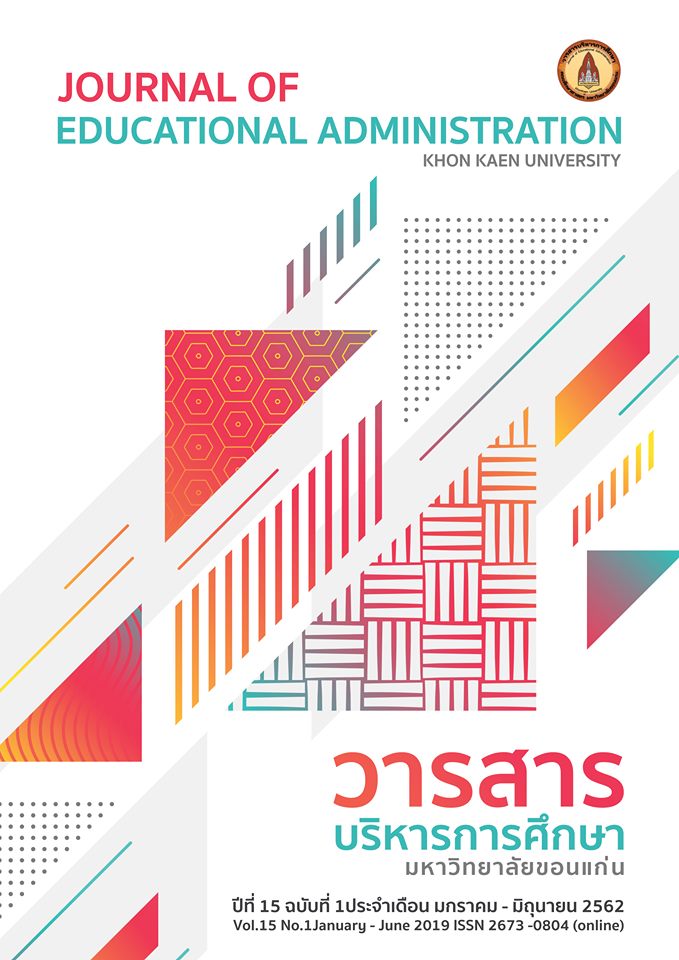การบริหารความเสี่ยงในสถานศึกษาขั้นพื้นฐาน สังกัดสำนักงานเขตพื้นที่การศึกษาประถมศึกษานนทบุรี
Main Article Content
Abstract
The purposes of this research were to 1) study the state of risk management in basic schools, Under the Nonthaburi Primary Educational Service Area Office2) compare risk management in basic schools and 3)to find ways to develop risk management in basic schools The sample group used in the research was 166 school administrators and teachers. The research instrument was the estimation questionnaire. Statistics used in data analysis were frequency, percentage, mean, standard deviation, t-test, F-test and Scheffe’s method and content analysis.
The research result showed that: 1. Risk management in basic schools Under the Nonthaburi Primary Educational Service Area Office Overall, it was at a high level (= 3.90) as a whole when considered in terms of the average, from high to low to the following: budget management (
= 3.98), personnel management (
= 3.91), general administration (
= 4.10) and academic administration (
= 3.85) respectively. 2. Comparative results, comments, risk management at Basic school Under the Nonthaburi Primary Educational Service Area Office classified by age education level and work experience was not different. 3. Guidelines for developing risk management in basic schools there should be as follows: 3.1 Academic administration, including assignments or responsibilities according to knowledge Personnel ability to enhance skills and potential of personnel Supervision, follow-up, there are educational development plans, teaching and learning management that focus on students is important, there are academic meetings, promotion of participation in all sectors, for the relevant communities to determine the vision, mission, and goals of the school. 3.2 On budget management, such as the use of budget of educational institutions, should adopt good governance principles to manage educational institutions, appointment of procurement committees in educational institutions, the implementation of plans, projects/activities, budget use, educational institutions clearly able to continuously monitor, have information systems and effective control technology. 3.3 Personnel management there should be creating morale for the personnel who work successfully Salary increase Promote and continuously develop personnel of educational institutions, sufficient manpower and suitable for the operation. There is an evaluation of the performance of personnel continuously and systematically, can be checked. Working together as a team and building human relations in educational institutions. 3.4 General administration, including joint management of personnel, educational institutions, and policy formulation, development plans Systematically manage the school structure with clearly assigned duties Emphasis on the management style of participatory management Create a good atmosphere and culture Have a building The location of materials and equipment to be sufficient for the management of educational institutions.
Article Details
References
กิตติศักดิ์ ผาลี. (2549). ความพึงพอใจของคณะกรรมการสถานศึกษาขั้นพื้นฐานต่อคุณลักษณะของผู้เรียนตามมาตรฐานการศึกษาด้านผู้เรียน ในโรงเรียนสังกัดสำนักงานเขตพื้นที่การศึกษาเลยเขต1.วิทยานิพนธ์ปริญญาครุศาสตรมหาบัณฑิต สาขาวิชาการบริหารการศึกษา บัณฑิตวิทยาลัย มหาวิทยาลัยราชภัฏเลย.
เกศสุดา ไกรนารา. (2556)การพัฒนาการบริหารความเสี่ยงในการบริหารงานวิชาการของสถานศึกษาขั้นพื้นฐาน สังกัดกรุงเทพมหานคร กลุ่มกรุงเทพใต้.วิทยานิพนธ์ครุศาสตรมหาบัณฑิต สาขาวิชาการบริหารการศึกษา บัณฑิตวิทยาลัยมหาวิทยาลัยราชภัฏสวนสุนันทา.
ดวงใจ ช่วยตระกูล. (2551). การบริหารความเสี่ยงในสถานศึกษาระดับการศึกษาขั้นพื้นฐาน. วิทยานิพนธ์ปริญญาปรัชญาดุษฎีบัณฑิต สาขาวิชาการบริหารการศึกษาบัณฑิตวิทยาลัย มหาวิทยาลัยศิลปากร.
ธร สุนทรายุทธ. (2550).การบริหารความเสี่ยงทางการศึกษา. กรุงเทพฯ: เนติกุล.
นฤมล บินหะยีอาวัง. (2553). ความคิดเห็นเกี่ยวกับการบริหารความเสี่ยงในสถานศึกษาขั้นพื้นฐานของผู้บริหารโรงเรียนเอกชนสอนศาสนาอิสลาม เขตกรุงเทพมหานครและปริมณฑล. วิทยานิพนธ์ปริญญาศึกษาศาสตรมหาบัณฑิต สาขาวิชาการบริหารการศึกษา บัณฑิตวิทยาลัย มหาวิทยาลัยรามคำแหง.
ประจักษ์ ทองแจ่ม. (2550). การศึกษาการบริหารของผู้บริหารสถานศึกษา ตามภารกิจของสถานศึกษาขั้นพื้นฐาน สังกัดสำนักงานเขตพื้นที่การศึกษาพิจิตรเขต 2. วิทยานิพนธ์ปริญญาครุศาสตรมหาบัณฑิตสาขาวิชาการบริหารการศึกษาบัณฑิตวิทยาลัย มหาวิทยาลัยราชภัฏเพชรบูรณ์.
ปราณี พรรณวิเชียร. (2552). การบริหารความเสี่ยง. ค้นเมื่อ 16 มิถุนายน 2559, จากhttps://www.eqd.rmutt.ac.th/document/RISK.ppt
ปรีชา จันทวี. (2553). การพัฒนาระบบการประเมินและการควบคุมความเสี่ยงทางการศึกษาสำหรับโรงเรียน : การประเมินแบบเสริมสร้างพลังอำนาจ.วิทยานิพนธ์ปริญญาปรัชญาดุษฎีบัณฑิตสาขาวิชาวิจัยและประเมินผลการศึกษาบัณฑิตวิทยาลัย มหาวิทยาลัยมหาสารคาม.
ไพรวัลย์ คุณาสถิตชัย. (2553). การบริหารความเสี่ยงด้านการเงินของมหาวิทยาลัยขอนแก่น. วิทยานิพนธ์ศึกษาศาสตรมหาบัณฑิต สาขาวิชาการบริหารการศึกษา บัณฑิตวิทยาลัย มหาวิทยาลัยขอนแก่น.
มนสิชา แสวัง. (2553). การบริหารความเสี่ยงของมหาวิทยาลัยเชียงใหม่. วิทยานิพนธ์ปริญญารัฐประศาสนศาสตรมหาบัณฑิตบัณฑิตวิทยาลัย มหาวิทยาลัยเชียงใหม่.
วินัย เวียงลอ. (2552). การบริหารความเสี่ยงด้านการเงินของโรงเรียนบ้านแม่แฮเหนือ อำเภอแม่แจ่ม จังหวัดเชียงใหม่. วิทยานิพนธ์ปริญญาศึกษาศาสตรมหาบัณฑิต สาขาวิชาการบริหารการศึกษา บัณฑิตวิทยาลัย มหาวิทยาลัยเชียงใหม่.
สุมนา เสือเอก. (2553). การบริหารความเสี่ยงของโรงเรียนอาชีวศึกษาเอกชนในกรุงเทพมหานคร. วิทยานิพนธ์ปริญญาครุศาสตรมหาบัณฑิต สาขาวิชาการบริหารการศึกษาบัณฑิตวิทยาลัยมหาวิทยาลัยราชภัฏธนบุรี.
สำนักงานปลัดกระทรวงศึกษาธิการ.(2550). การบริหารความเสี่ยงของสำนักงาน ปลัดกระทรวงศึกษาธิการ แผนปฏิบัติราชการประจำปี. ค้นเมื่อ16 มิถุนายน 2559,จาก www.nidtep.go.th/nidtep/articles/plan11.doc.
สำนักงานรับรองมาตรฐานและประเมินคุณภาพการศึกษา (องค์กรมหาชน).การประเมินคุณภาพภายนอกระดับการศึกษาขั้นพื้นฐาน. ค้นเมื่อ 16 มิถุนายน 2559, จากhttps://www.onesqa.or.th/onesqa/th/Report/ index.php.
Fleming,M. L.,&Levie, W.H. (1984).Instructional Message Design: Principles from theBehavioral Sciences(4thed.).Englewood Cliffs, NJ: Educational Technology Publications.
Flippo, E. B. (1961). Principles of Personnel Management.New York: McGraw-Hill.
Kotler, P. (1997). Marketing Management: Analysis,Planning, Implementation and Control (9thed.).Upper Saddle River, NJ: Prentice Hall.
Saylor, J.G., Alexander, W. M.,& Lewis, A. J. (1981). Curriculum Planning for Better Teacher and Learning. 4th ed. New York: Holt.
Schiffmand,L. G.,&Kanuk,L. L. (1994). Consumer Behavior(5thed.). Englewood Cliffs, NJ: Prentice Hall.
Taba, H. (1962). CurriculumDevelopment: Theory and Practice.New York: Harcourt, Brace & World.

